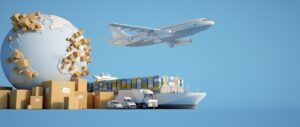Important information and tips
The European Economic Area (EEA) is a free trade area that allows member states to simplify exports, thus helping to strengthen the economy. Members of the EEA are the member states of the EU and three countries of EFTA: Iceland, Liechtenstein and Norway. What makes the EEA special are the four freedoms of movement of goods, people, services and capital. But what happens when companies want to export goods across the borders of the EEA? What requirements and what costs apply to such an export? We have investigated this question in our article.
Customs duties apply

For the export of goods to countries outside the EU, it is necessary to check whether and which customs duties are incurred. In principle, the recipient of the goods is obliged to pay the customs duties. The fees must be paid before the goods are received. The amount of customs duties depends on the country to which the goods are exported. Most countries have set allowances below which no customs duties are payable. Nevertheless, it is always necessary to declare the import of goods to customs. In order to relieve the recipient – especially if it is a private person – in practice the importer or exporter takes over the declaration at customs and the handling of the payment of customs duties.
How much are the customs duties?
Since each country sets customs duties individually, no blanket statement can be given regarding the amount of customs duties. It is common to use the value of goods as a basis for calculation. The percentage defined by the importing country is applied to this value of goods. Exemption limits must be taken into account; below these exemption limits, customs duties do not apply. Customs duty is paid on all goods that are not clearly intended for personal use. There are no customs duties for goods to be exported, but the export of goods is always connected with the import of the goods into another country. Here, customs duties are due again.
The declaration of the export at the customs
Customs distinguishes different procedures when declaring the export of goods, depending on the type of export:
- Final export
- Temporary export
- Re-export
Final export is the normal procedure. The goods are exported from an EU country to a non-EU country. The procedure includes two stages.
Step 1:
In the first step, the export procedure is opened at the customs office of export. Companies or transport companies contact the relevant customs office. It is necessary to indicate there that a certain good is to be exported. An electronic export declaration must be made for the goods. Representation is possible and common. Two different forms of representation are allowed:
- direct (representative acts in the name and on the account of the owner of the goods)
- indirect (representative acts in his own name and for the account of the owner of the goods).
Once the declaration has been made, the customs office of export examines the declaration and the goods. In particular, it is necessary to check whether the export is admissible. If this check was completed positively, then an Export Accompanying Document (EAD) is created. The goods are now released for export.
Step 2:
The goods and the EAD are usually presented by the driver to the customs office of exit upon export. It is checked whether the goods entered in the EAD correspond to the actual goods. The export procedure is completed if no irregularities are found in this regard.
Not all goods may be imported

(stock.adobe.com © Andrii Yalanskyi)
The import of goods is subject to the respective restrictions of the importing country. On the one hand, there are fundamental import bans for certain groups of goods, on the other hand, the importable quantity may be limited. The laws of the importing country determine which restrictions apply. It is also possible that the import of certain goods is subject to certain conditions, such as a special permit. Customs is responsible for checking the permissibility of importing goods.
Duty exemption possible for certain groups of goods
In order to promote trade in defined areas between countries, duty-free treatment of certain products can be agreed. Duty-free treatment applies to the respective products and between the countries involved. An example is agriculture, which is promoted by various countries and has led to the introduction of duty-free treatment for certain agricultural products. Low or eliminated customs duties are a financial advantage, especially for the buyers of the products, as the sellers are inclined to pass on the customs duties to the end consumers.
Cooperation with a professional exporter
If companies export goods to countries outside the EEA, then cooperation with a professional exporter is advantageous. The exporter has an extensive network and thus ensures that the best route or the most favorable transport route is found. Depending on the goods and the destination country, transport by land, sea or air can be considered. Each mode of transportation has its own advantages, such as high speed by air even over long distances or the possibility of shipping large quantities of goods in sea containers. Cargo handling and the transport of goods are primarily associated with logistical effort. Transport companies pool resources here, resulting in cost savings in contrast to the organization of transport by individual companies.
Export: Various conditions may apply

(stock.adobe.com © STOATPHOTO)
If companies export goods to different countries outside the EEA, then individual conditions apply to the destination countries. The differences in import regulations, customs duties and possible transport routes lead to different costs for the transport. The goods reach their destination at different speeds, and export involves different costs. For entrepreneurs, this circumstance means that price calculations must be made individually for each country. Customs duties are payable by the consignee, but in this case buyers are often not prepared to pay high prices, but instead evaluate the total costs, including customs duties, when making their purchase decision.
The translation of documents
Ensure that all required documents are in the language required by the importing country. Many countries allow the use of English language documents, but not all countries do. To prevent goods from being held up at customs, exporters must clarify in advance which documents must be translated into which languages. These must be official and recognized translations that meet the formal requirements of the document form. It is possible to add the documents in different languages to the goods, especially if the transport crosses several national borders. In the case of import, it is indicated whether the goods only pass the national borders or whether the goods remain in the country. This question is particularly relevant to the question of the amount of customs duties.
Conclusion
Export across the borders of the EEA is possible and common, as is transport to countries within the EEA. By cooperating with a professional transport company, the effort and costs are reduced.









